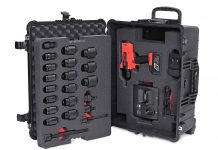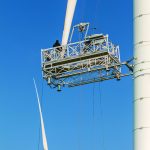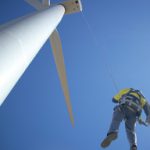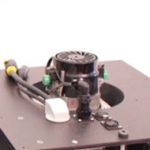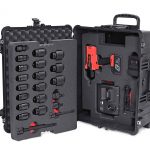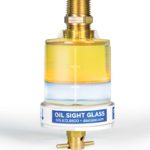You wouldn’t leave your dog in a car on a hot, sunny day. So, why would you leave your wind technician in a turbine to roast in the summer sun? Okay, seriously, heat stress is a very real concern that should not be taken lightly. Public service announcements warn us that a car can reach temperatures of 140° F within an hour in the sun. A wind turbine nacelle can get just as hot, especially when you consider that the gearbox can serve to heat things up from the inside out while solar energy works from the outside in.
According to the Center for Disease Control (CDC), “On average, 675 people die from complications related to extreme heat each year in the United States — more than tornadoes, hurricanes, floods, lightning or any other weather event combined.” Heat cramps, heat exhaustion, and heat stroke affect thousands of Americans every year.
Company EHS policies often dictate safety measures that must be taken during these hot months. If these measures are officially written into the EHS policy, then OSHA requires that they be followed, even if they exceed official OSHA requirements. Shawn Lamb, CEO of Danish Windpower Academy Americas, said he remembers the Florida heat while rebuilding roofs for the disaster relief effort after Hurricane Charley. “We could only work 20 minutes at a time in shifts.” Lamb, also a former instructor for GE Wind, said, “Palm Springs was the only GE site that would allow technicians to wear shorts.” Shorts, normally considered to be less-than-ideal attire in terms of safety in a wind turbine, can be considered to be a hazard mitigation tool for dealing with extreme heat.
Three Stages of Heat Emergencies
While in charge of multiple crews as the Operations Manager for BIS Salamis and Resources Technician for Vestas, Ecotech Institute’s Wind Energy Program Director, Auston Van Slyke kept a close eye on the technicians under his authority. “Remember, it starts with cramps and starts getting dangerous with exhaustion. If you reach heat stroke, permanent damage has already been done.” As a part-time American Red Cross First Aid/CPR/AED instructor, Van Slyke trains wind turbine technicians how to recognize the three stages of heat emergencies:
Heat Cramps — The first stage of a heat emergency, heat cramps, are quite simply recognizable by the victim as muscle pain and tightness. Since these are also symptoms of a really effective workout at the gym, previous recreational activity, or overtaxing muscles during a work shift, it can be easily overlooked as a heat-caused issue. Such an oversight might allow the heat emergency to escalate to the next stage.
Treat heat cramps by moving to a cooler environment, resting, and drinking water and electrolytes at a slow but steady pace. Cramped muscles can be massaged and stretched for relief. The victim should not rule out seeking medical attention.
Heat Exhaustion — According to the American Red Cross (http://www.redcross.org/prepare/disaster/heat-wave), in addition to heat cramps, the second stage of a heat emergency can include any or all of the following symptoms:
• dizziness
• headache
• irritability
• extreme thirst
• nausea or vomiting
• pale skin
• heavy sweating
• fainting
In most cases, treat heat exhaustion the same way that you would heat cramps, but definitely seek medical attention right away. If the victim is vomiting or has fainted, do not make them drink water until these symptoms have passed. Heat exhaustion can escalate quickly to a potentially fatal condition.
Heat Stroke — Heat stroke is the most serious of the three stages of heat emergencies. In addition to all of the symptoms noted for heat exhaustion, the American Red Cross advises that heat stroke can include the following:
• body temperature over 105° F
• irrational behavior
• confusion
• rapid, shallow breathing
• rapid, weak pulse
• seizures
• loss of consciousness
A victim of heat stroke should be considered to be in a very serious condition. Call 911 immediately! The victim’s body is past the point of having any ability to cool itself through the process of perspiring. While awaiting the emergency response, apply cool, damp cloths to the victim’s neck, face, chest, arms and legs. Ice or cold packs, if there are any around, can be applied to the underarms, wrists and groin. A body temperature at or above 105° F will often lead to some level of brain damage and possibly even death, so it is critical to help the victim to reduce his to her body temperature while waiting for help to arrive.
Preventing heat stress
Awareness — Knowing the risks and watching for the signs of heat stress in both our coworkers and ourselves is key to working safely in a hot environment. Be especially aware of the onset of symptoms experienced by new employees. OSHA reminds us that it can take some people two to three weeks to acclimatize to a hotter environment as well as to the strenuous labor of working on wind turbines. New employees will often overwork themselves to prove themselves to veteran technicians; summer heat can turn this effort into a dangerous situation quickly. Assign less strenuous tasks for the new guys and gals until they can be trusted to work safely in the heat. Similarly, carefully watch even experienced coworkers who are returning from a two to three week vacation where they possibly spent their time enjoying cooler temperatures.
Hydration — Veteran turbine troubleshooter and wind energy instructor, Derek Johnson, has seen a common pattern amongst wind technicians. “So often you see wind techs neglect hydration because they are so focused on the task at hand,” Johnson comments. OSHA recommends four cups (32 ounces) of water every hour. One cup every fifteen minutes is preferable to guzzling the full 32 ounces on the hour. Do not exceed six cups per hour as this can deplete your body of electrolytes and cause other health complications that, if extreme, can be fatal. Mixing water with an electrolytic sports drink can help with this. Small hydration packs of powdered electrolytes, like the ones made by Sqwincher™, can be carried in a worker’s pocket and mixed with water when needed. Alcohol and caffeine may dehydrate a body more than they help to hydrate one. Avoid alcohol consumption in general during the hottest periods of the year, and choose decaffeinated drinks instead. Did I lose you there, dear reader?
Reduce Workplace Temperature – Contrary to popular belief, fans do not cool the air. They do however increase evaporation from the skin, which has a cooling effect on the body. Placing some fans strategically in the nacelle to circulate air is a very easy measure with a huge reward. Be advised, however, that if a heat stressed person has reached the point that they stop sweating, a fan will have little effect, and at this point medical attention is past due. Ensuring maximum natural ventilation through a nacelle can help, so open any hatches that don’t pose their own hazards to technicians such as any that a technician could fall through. If you’ve ever felt the air rush up a tower when the roof hatch of a nacelle has been opened, you can appreciate what a relief this can be. Also, whenever feasible, shutting down a turbine early to let the gearbox cool is a measure that comes with a small but worthwhile production price tag. Scheduling strenuous tasks for the early morning or evening hours is a common practice for many sites. Many companies will require or advise site managers to schedule the workday much earlier in the day during the summer months. Reporting for work at 5 a.m. may not sound like fun, but clocking out in the early afternoon is a nice perk.
Reduce Body Temperature — Everyone knows that standing in front of a fan is the place to be on a hot day. Take short breaks frequently to cool off; You won’t be seen as a workplace hero by skipping breaks if it results in you being lowered to the ground in a rescue procedure. For that matter, encourage your coworkers to take cooling breaks as well. Workers can buy neckbands and pads with dried polymer crystals inside. These crystals swell to a gel in cold water that cools the skin and blood vessels within. Some bands and pads are made specifically for industry and construction workers and, when used according to the manufacturers, will not interfere with the effectiveness of personal protective equipment (PPE)
Monitoring the Risk
OSHA offers a free app for smartphones and tablets to monitor the heat risk level with real-time updates of current temperatures. The app also provides the signs and symptoms listed earlier in this article as well as advised treatment for each of the three conditions. OSHA’s app also provides a calculator to combine temperature and humidity to determine the heat index often denoted by the term “feels like”. For example, if the thermometer reads 108° F and humidity is at 83%, the heat index will tell you it “feels like 212° F” which is the temperature at which water boils at sea level. Ouch!
If the site has a technician or manager monitoring the SCADA system and watching for thunderstorms, this person can also keep an eye on outside temperature readings. The SCADA-watcher should engage in frequent communication with technicians in the turbines to remind them to rest and drink water, check nacelle heat readings, and to be ready for the distress call that might come.
At some point, common sense and a concern for safety will compel a site manager to simply shut down all repairs and maintenance for the day. When that happens, go home, stick your face in the freezer for a minute, drink a frosty non-alcoholic beer or decaffeinated iced coffee, and enjoy your time watching the Weather Channel to see what tomorrow will bring.

















